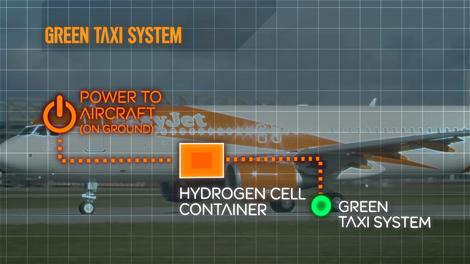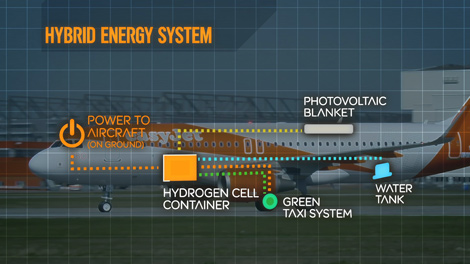
Easyjet is planning a new hybrid design concept for its A320-family aircraft which will see a hydrogen fuel cell stowed in the aircraft’s hold to reduce fuel consumption while the aircraft is on the ground.
On average, Easyjet’s taxi time is 20 minutes per flight, the equivalent of around four million miles a year. The new design concept would see energy captured as the aircraft brakes on landing.
This energy would then be used to charge the lightweight Hydrogen’s fuel cell system’s batteries when the aircraft is on the ground. (Easyjet says the system is similar to that of the Kinetic Energy Recovery System (KERS) found in Formula 1 cars.)
The plan is for the energy captured to then be used by the aircraft for taxiing, potentially saving the airline up to four per cent of Easyjet’s total fuel consumption.
Easyjet estimates that if successful, the new concept would save around 50,000 tonnes of fuel and the associated CO2 emissions per year.
The only waste product of the system is fresh clean water which could be used to refill the aircraft’s water system throughout the flight.
To power the aircraft during taxiing, each aircraft would have power motors fitted in their main wheels. Power electronics and system controllers would give pilots control of the aircraft’s speed, direction and braking during taxi operations.
The system would therefore reduce or even remove altogether the need for tugs to manoeuvre aircraft in and out of stands. It would also allow the airline to become efficient turnaround times and increased on time performance.

For the hybrid plane concept, the airline has worked with students at Cranfield University who were asked to develop ideas for what air travel might look like in twenty years’ time, as part of a competition to celebrate Easyjet’s 20th birthday in November 2015.
Head of Engineering, easyJet, Ian Davies, commented: “The hybrid plane concept we are announcing today is both a vision of the future and a challenge to our partners and suppliers to continue to push the boundaries towards reducing our carbon emissions. It’s also a great example of the benefits of our strategic relationship with Cranfield University.”
Dr. Craig Lawson, Lecturer, Centre for Aeronautics, Cranfield University, added:
“We are delighted to be working on this project with Easyjet on what is a real-world example of how we can innovate together.
“Our students have showcased some exciting ideas for the 2035 vision of the airline industry through The Future of Flight competition, presenting environmental solutions, operational improvements and ideas to enhance the customer experience. We’re looking forward to developing this concept further.”

Easyjet and Cranfield University signed a three-year strategic partnership agreement last year to share innovation and knowledge.
As part of Easyjet’s 20th birthday activities, students at Cranfield University were asked to compete in four categories; cabin design, aircraft design, airport experience and in-flight experience. Other ideas included dynamic wings which change shape in flight, a super-efficient ‘shark skin’ coating to reduce surface drag and, in the cabin, ultra-light weight seats carbon fibre seats incorporating wireless phone and tablet charging panels.
Easyjet operates a fleet of over 240 Airbus A319s and A320s with an average age of just six years old. The airline will start taking delivery of A320neo aircraft from June 2017.
These new planes will be around 13-15 percent more fuel efficient than the planes they are replacing. It carries over 68 million passengers annually, of which more than 12 million are travelling on business. Easyjet flies over 240 aircraft on more than 750 routes to over 130 airports across 32 countries.
This week Easyjet also launched its 27th base at Venice airport, with ten new services including flights to Bristol and Edinburgh (see news February 1).
Tom Otley








